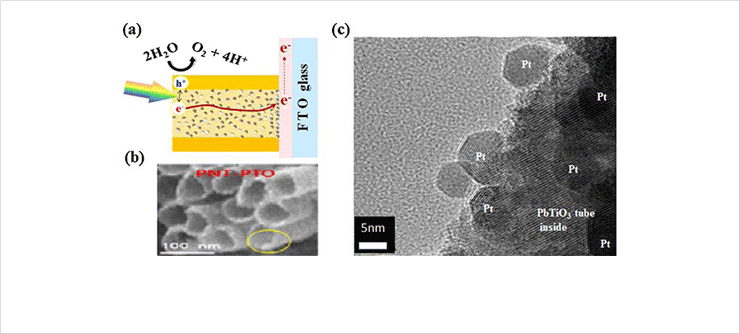Representative Research Publications
Effective charge separation in site-isolated Pt-nanodot deposited 2018 > Representative Research Publications > Research Results Home
Effective charge separation in site-isolated Pt-nanodot deposited PbTiO3 nanotube arrays for enhanced photoelectrochemical water splitting.
- Applied Catalysis B: Environmental / 2018 March
- Kim, Hyun Gyu (Corresponding author)
Study Summary
A photoelectrode made of PbTiO3 particles usually generates much lower photocurrents than TiO2 although it absorbs a larger fraction of the sunlight. Here we adopted two synthetic strategies to improve PEC performance of PTO. First, one-dimensional (1-D) nanotube arrays of PbTiO3 (denoted as NT-PTO) was fabricated by a hard template method. In the nanotubes, electrons experience a quantum confinement in the transverse direction, and thus travel only in one direction along an axial quantum channel. This would decouple the transport paths of electrons and holes and thus reduce their recombination.
This highly nano-engineered photoanode reduced the energy-wasteful electron-hole recombination, and thus enhanced efficiency in PEC water splitting relative to reference electrodes made of PbTiO3 nanotubes (no Pt-dots) or PbTiO3 powders (no nanotube).
Expected Effects
We have successfully fabricated the PbTiO3 nanotube arrays over a thermally sensitive transparent conducting glass (FTO) substrate. A new concept of site isolation has been realized by Pt-sol infiltration in the internal core of deposited nanotube arrays and thus physically separating electron and hole reaction sites on the internal and external surfaces of the nanotubes, respectively. The effective charge separation leads to greatly enhanced photocurrent generation and H2 evolution efficiencies relative to those of the particulate-type or nanotube-type photoanode without Pt infiltration. The physical site isolation through nano-engineering of the material fabrication demonstrated in the present work could offer a new strategy for preparation of high-efficiency PEC devices.
 Figure 1. (a) Schematic model displaying light absorption followed by an efficient electron-hole separation by tunneling electrons inside and holes
outside of a nanotube in the Pt dots@ PbTiO3 nanotubes photoanode. (b, c) FE-SEM and HR-TEM (circled area) images of the top of nanotube displaying the presence of Pt nanodots on the internal surface of the nanotube.
Figure 1. (a) Schematic model displaying light absorption followed by an efficient electron-hole separation by tunneling electrons inside and holes
outside of a nanotube in the Pt dots@ PbTiO3 nanotubes photoanode. (b, c) FE-SEM and HR-TEM (circled area) images of the top of nanotube displaying the presence of Pt nanodots on the internal surface of the nanotube.



